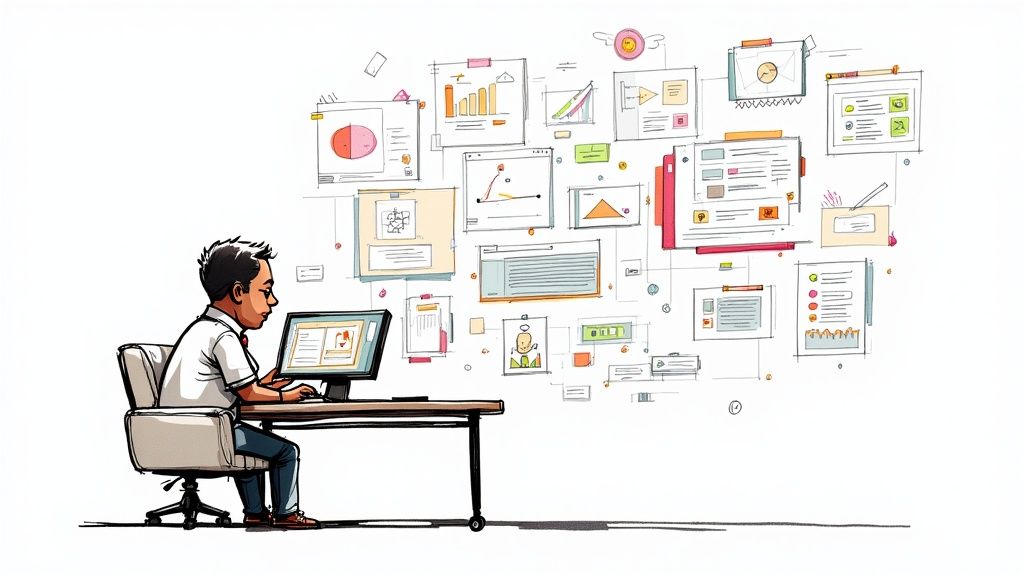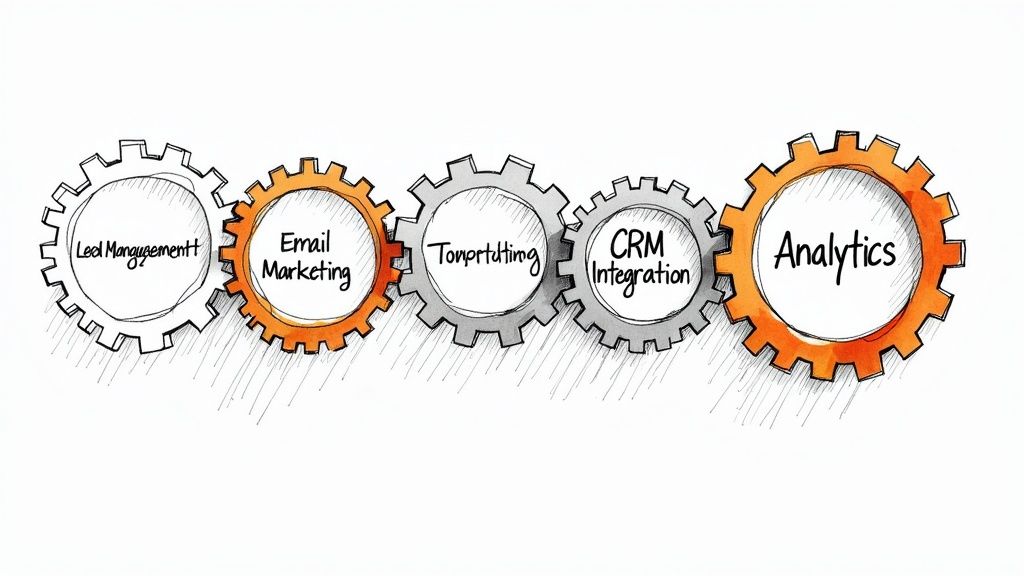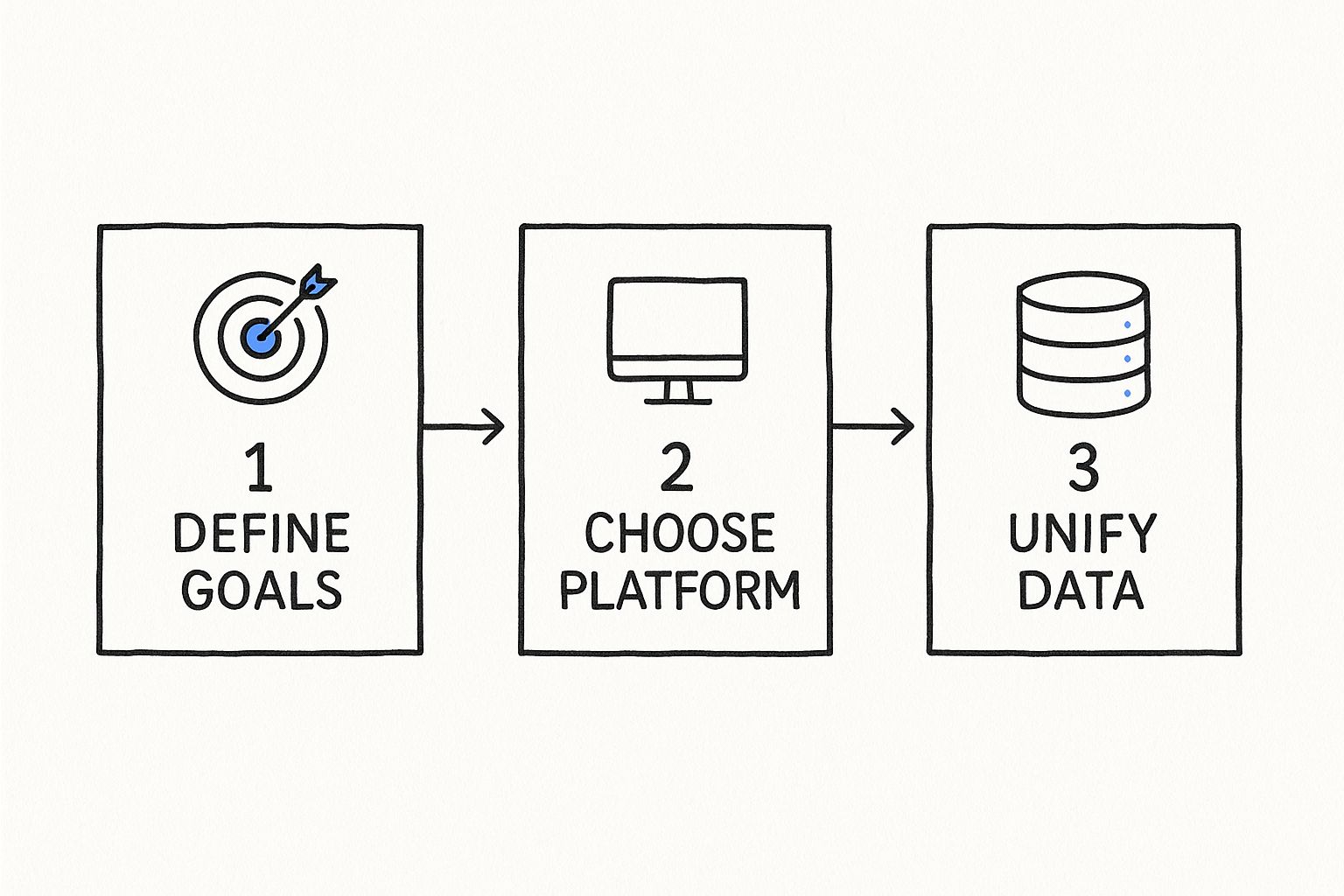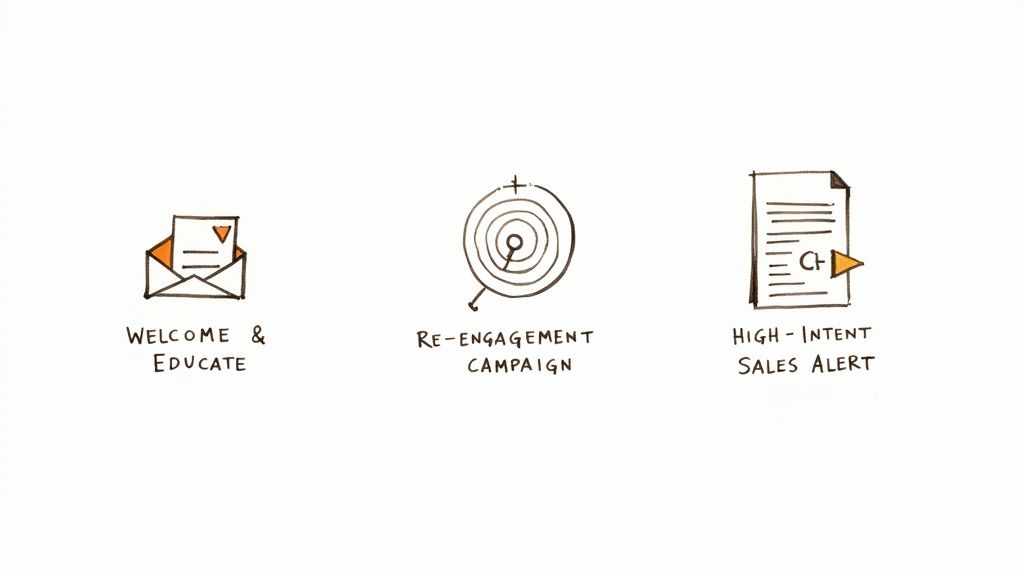Business to Business Marketing Automation: Your Ultimate Growth Engine
Business to business marketing automation is your secret weapon for ditching repetitive tasks and building a revenue-generating machine. It’s how you nurture client relationships at scale, transforming chaotic manual work into a clean, predictable system for growth. Stop chasing leads; start attracting them automatically.
What Is B2B Marketing Automation Anyway?

Cut the jargon. B2B marketing automation is your team's tireless digital assistant. It doesn’t replace people; it frees them to focus on high-impact strategy and creative work—the stuff humans do best.
This isn’t just scheduling posts. B2B automation is built for the long, complex journey a business client takes before signing a deal. It manages relationships across dozens of touchpoints over months, sometimes years.
Instead of your team manually tracking every interaction, the platform does it for you. It logs every website visit, content download, and email open, building a rich profile for every prospect. This data is pure gold. It’s what lets you send hyper-relevant messages that feel personal, even when sent to thousands.
It's More Than Just Automating Tasks
The real power move is shifting from automating busywork to building a system for growth. You move from reactive, one-off campaigns to a proactive, "always-on" revenue engine.
Here’s what that actually looks like:
Systematic Lead Scoring: The platform automatically scores leads based on their behavior and firmographics. A prospect who visits your pricing page three times gets a higher score than someone who just downloaded a top-of-funnel guide.
Intelligent Lead Nurturing: Based on that score, the system triggers a pre-built sequence of helpful content. This keeps prospects engaged and builds trust through the long B2B sales cycle—all on autopilot.
Precise Audience Segmentation: Slice your audience into laser-focused groups. Target VPs of Operations in manufacturing who have viewed your case studies. Every message hits its mark.
This creates a seamless handoff from marketing to sales. Once a lead hits a target score—a clear buying signal—the system instantly alerts a sales rep and delivers the prospect’s entire engagement history. No more cold calls, only warm conversations.
B2B marketing automation closes the gap between marketing activities and sales results. It builds a predictable pipeline by ensuring no qualified lead falls through the cracks and every prospect gets the right information at the right time.
The Daily Grind vs. The Strategic Advantage
See the difference for yourself. One side is the daily grind; the other is a genuine competitive edge.
Marketing Task | Manual Approach (The Grind) | Automated Approach (The Advantage) |
|---|---|---|
Lead Follow-Up | A salesperson manually sends a generic follow-up email hours or days later. | An instant, personalized email is triggered. The lead is tagged and enters a relevant nurture sequence based on their form entry. |
Lead Qualification | Sales reps waste hours sifting through long lists, guessing who’s hot and who’s not. | The system scores leads automatically based on behavior (visited pricing page) and demographics. Sales gets a prioritized list. |
Nurturing Campaigns | Marketing sends a monthly newsletter to everyone, hoping something sticks. Most leads go cold. | Leads receive a tailored drip campaign with content matching their specific interests and buying stage. |
Sales & Marketing Handoff | Marketing emails a CSV of "hot leads" to sales at week's end. Key context is lost. | The platform automatically assigns a sales-ready lead to a rep in the CRM and creates a task, complete with their full activity history. |
Reporting & ROI | You piece together data from Google Analytics, email stats, and CRM reports to guess what worked. It's a mess. | A unified dashboard shows exactly which campaigns generate leads, pipeline, and closed-won deals, providing clear ROI. |
The choice is clear. Trade low-impact, repetitive work for high-impact, scalable systems.
The Strategic Shift
This isn't just a new tool—it's a new way to operate. It transforms your marketing department from a cost center focused on "activities" into a revenue engine with documented results.
You stop guessing and start knowing what drives pipeline and closes deals. This shift frees your team from spending 80% of their time on manual execution. Instead, they focus on the strategic work that grows the business: analyzing data, refining messaging, and launching bigger, bolder campaigns, knowing the fundamentals are running perfectly in the background.
The Core Components of Your Automation Engine

A B2B marketing automation platform isn't a black box. It's an engine made of distinct parts, each with a critical job. Understand the parts, and you'll master the machine that pulls in leads and primes them for sales.
Think of it like a high-performance car: fuel system, transmission, onboard computer. Each part has a role, but together they deliver speed, efficiency, and control.
Let’s pop the hood and inspect the four pillars that make this engine roar.
Lead Management: The Smart Sorting System
Lead management is the brain of the operation. It captures, organizes, and prioritizes every lead, ensuring your sales team only spends time on the hottest opportunities. This is lightyears beyond dumping emails into a spreadsheet.
The magic is lead scoring—a system that assigns points to prospects based on who they are and what they do. A director from a target industry? +10 points. They visit your pricing page? +15 points.
This automated process instantly separates the browsers from the buyers, so your reps stop wasting time on dead-end conversations.
Here's how it plays out:
Capture: A prospect fills out a form to download a whitepaper.
Enrich: The system automatically finds public data like their company size and job title.
Score: They get a score based on their profile and behavior (pages visited, emails opened).
Route: Once a lead hits a threshold—say, 100 points—they're automatically assigned to a sales rep in the CRM with an instant alert.
Email Marketing: The Personalized Messenger
At the heart of any solid B2B automation engine are powerful email automation strategies. This isn't about blasting generic newsletters. It's about sending the right message at the right time, triggered by user actions.
This is where you build nurture campaigns: automated email sequences designed to educate prospects, build trust, and guide them through a long B2B sales cycle.
A prospect downloads a whitepaper on "AI in Logistics." They're automatically entered into a three-week email workflow sending related case studies, webinar invites, and blog posts on that exact topic. This is personalization at scale.
These systems run on triggers and logic. If a prospect clicks a link about a specific product feature, you can tag them with that interest and follow up with more targeted info. To see how these sequences come together, learn about designing effective marketing automation workflows that convert.
CRM Integration: The Single Source of Truth
Your marketing automation platform and your CRM must be joined at the hip. A seamless CRM integration is non-negotiable. It creates one unified view of every customer and prospect.
Without it, marketing and sales operate in separate silos. With it, everyone reads from the same playbook.
This integration ensures all marketing activities—email opens, website visits, content downloads—appear directly on the contact's CRM record. A salesperson sees a lead's entire journey before picking up the phone, leading to warmer, more relevant conversations.
Analytics and Reporting: The Revenue Compass
Finally, analytics prove your effort is paying off. This is how you connect marketing activities directly to pipeline and revenue, giving you a concrete answer to the CFO's favorite question: "What's our ROI?"
This is where B2B marketing automation truly shines. No more guessing. Just cold, hard data.
A good analytics dashboard delivers critical insights:
Campaign Performance: See which emails and content generate the most qualified leads.
Lead Source ROI: Know if LinkedIn ads or blog posts deliver more valuable customers.
Sales Funnel Velocity: Track how fast leads move from first touch to closed deal and spot bottlenecks.
This is what turns marketing from a cost center into a documented revenue engine. You can walk into any meeting and show that for every dollar invested, you generated a specific amount of pipeline.
Why Smart B2B Companies Are Doubling Down on Automation
Let's be clear: B2B marketing automation isn't just about speed—it's a strategic play for predictable revenue. The real reason smart companies are boosting their budgets is to get tangible, bottom-line results.
It's a mindset shift from marketing as a cost center to a revenue multiplier. The question is no longer, "How much does this cost?" but, "How much revenue can this engine generate?"
The answers are compelling. In 2025, automation is a top B2B priority. Data shows 54% of B2B pros expect to moderately increase their automation spend, with another 19% planning a significant boost. Nearly three-quarters of the market is doubling down to sharpen data, nail personalization, and run a tighter ship. Explore more B2B marketing automation trends and budget insights.
Shortening the Long B2B Sales Cycle
The B2B buying journey is a marathon, often involving a committee of decision-makers over several months. Managing this manually is a recipe for dropped leads and lost deals.
Automation changes the game. It creates a persistent, organized communication channel that ensures no lead goes cold.
By delivering the right educational content at the right moment, you build trust and answer questions before they're asked. This systematic nurturing keeps your brand top-of-mind and dramatically shortens the time from first contact to a sales-ready conversation.
Delivering Superior Lead Quality
Not all leads are created equal. Sales teams burn too much time chasing tire-kickers. Marketing automation acts as a powerful filter, ensuring only high-intent, qualified leads land in your sales reps' pipeline.
This is powered by intelligent lead scoring. The system tracks every interaction—pricing page visits, case study downloads, webinar sign-ups—and assigns points. When a lead hits a target score, they’re not just a contact; they’re a validated prospect who has shown active interest. This delivers big wins:
Higher Conversion Rates: Sales talks to people who are already educated and engaged.
Increased Sales Productivity: Your team spends time closing deals, not sifting through cold lists.
Better Sales and Marketing Alignment: Both teams finally agree on what a "good lead" looks like, ending the friction.
Enabling Hyper-Personalization at Scale
In B2B, personalization isn't just using a first name. It's proving you understand a prospect's industry, challenges, and business needs. Doing that manually for thousands of leads is impossible.
Automation is your superpower. It lets you slice your audience into precise micro-segments and deliver custom-tailored content journeys for each one.
Imagine a workflow just for VPs of Finance in the SaaS industry who have used your ROI calculator. They get case studies and testimonials from their peers, not generic fluff. This deep relevance builds incredible credibility and turns you from just another vendor into a valued partner.
Your Step-by-Step B2B Automation Implementation Plan
Jumping into business to business marketing automation can feel daunting, but it doesn’t have to be. Forget dense technical manuals. This is your actionable roadmap for a successful rollout designed for quick wins and sustained momentum.
Think of it as a blueprint for a house. You wouldn't start building without a plan. This is your blueprint for a powerful automation engine that generates real results.

This process visualizes the core steps—defining goals, picking the right platform, and cleaning up your data—that set the stage for a smooth implementation. It all starts with clarity, ensuring your tech and data are perfectly aligned with your business objectives from day one.
Stage 1: Define Your Goals
Before you look at a single platform, answer one question: What specific problem are you solving?
Vague goals like "improve marketing" are useless. You need clear, measurable objectives to guide every decision.
Pinpoint your biggest headaches. Is your sales funnel leaking? Are you struggling to generate qualified leads? Is your sales team wasting time on contacts who aren’t ready to buy? Turn the problem into a tangible goal.
Solid examples:
Increase Marketing Qualified Leads (MQLs) by 30% in six months.
Reduce sales cycle length by 15% by automating lead nurturing.
Improve the MQL-to-SQL conversion rate from 5% to 10% this quarter.
With specific goals, your platform becomes a tool to achieve a defined outcome, not just fancy software. This clarity is the single most important factor for success.
Stage 2: Choose the Right Platform
Now that you know your mission, you can shop for tools. The market is crowded. It's easy to get distracted by flashy features you'll never use. Stick to what matters for your goals.
Key decision factors:
CRM Integration: How well does it sync with your CRM? This is non-negotiable. Clunky integration creates data silos and kills efficiency.
Ease of Use: Can your team build and manage workflows without a developer? A platform that's too complex will just gather digital dust.
Scalability: Will this platform grow with you? Think three to five years ahead, not just three months.
Don't let a sales rep sell you on features you don't need. If your goal is lead nurturing, you don't need a complex social media suite. Match the tool to the job.
Key B2B Automation Platform Features
Here’s a quick look at top players in the B2B automation space. This isn't exhaustive, but it shows how different platforms serve different needs.
Platform | Ideal For | Standout Feature | CRM Integration Strength |
|---|---|---|---|
SMBs & Mid-Market | All-in-one platform with a user-friendly interface. | Native integration with HubSpot CRM (very strong). | |
Enterprise | Advanced lead scoring and deep analytics. | Strong integration with Salesforce, Microsoft Dynamics. | |
Pardot (Salesforce) | B2B Salesforce Users | Seamless integration with Salesforce CRM. | Best-in-class, as it's a Salesforce product. |
SMBs | Powerful email automation and SMB-friendly pricing. | Good, with integrations for most major CRMs. |
The "best" platform is the one that fits your specific goals, team, and budget. Use this as your starting point.
Stage 3: Unify Your Data
This is the most critical and most-skipped step. Your automation platform is only as smart as the data you feed it. Get your data house in order before launching a single campaign.
This means cleaning, organizing, and consolidating your contacts. You can't run effective campaigns if your database is a mess of duplicates, outdated emails, and missing fields. A clean database is the bedrock of personalization and segmentation.
To get this right, you must understand strategic business to business segmentation.
Stage 4: Build Your First Workflow
Don't try to boil the ocean. Start small. Pick one simple, high-impact workflow to prove the concept and score a quick win. A lead nurturing campaign for new ebook downloads is a perfect start.
Here’s the play:
Trigger: A prospect fills out a form to download your "Ultimate Guide to X."
Immediate Action: Instantly send an email with a link to the guide. No waiting.
Follow-Up (3 days later): Automatically send a related blog post or case study.
Follow-Up (1 week later): Send an invite to a relevant upcoming webinar.
This simple sequence ensures no lead goes cold and provides immediate value—all on autopilot.
Stage 5: Measure and Optimize
Your work isn't done at launch. The final stage is a continuous loop: measure, learn, optimize. Circle back to the goals from Stage 1. Are you hitting your numbers?
Use your platform's analytics to see what's working. Check email open rates, click-through rates, and, most importantly, conversion rates. If an email is bombing, tweak the subject line. If a workflow isn't generating qualified leads, adjust the content.
This data-driven approach turns a good automation strategy into a great one.
Proven B2B Marketing Automation Plays You Can Use Today

Theory is nice, but results matter more. The best way to grasp business to business marketing automation is to see it in action. These aren't complex, six-month projects. They are battle-tested plays you can roll out now for real impact.
Think of them like recipes: a clear trigger, a series of automated actions, and a specific goal. They are high-impact starting points for your automation journey.
Let’s break down three powerful plays to turn engagement into revenue.
The Webinar Welcome and Education Series
Webinars are lead-gen gold, but the real magic happens after the event. A simple "thank you" email isn't enough. This play turns attendees into educated, qualified prospects by methodically delivering value.
Trigger: Someone registers for your webinar.
Action 1 (Instant): Fire off a confirmation email with calendar links and a "what to expect" note.
Action 2 (Pre-Webinar): The day before, send a reminder. Pro tip: include a relevant blog post link to get them thinking.
Action 3 (Post-Webinar): Within an hour of the webinar, send the recording and slides to everyone who registered—even no-shows.
Action 4 (3 Days Later): Segment your list. Send attendees a targeted case study. Send no-shows a "sorry we missed you" email.
The Outcome: You're no longer hosting a one-time event; you're creating an educational journey. This positions you as an expert, keeps the conversation going, and warms up leads for sales.
The High-Intent Sales Alert Workflow
Automation's biggest win is speed. This play is your instant alert system, notifying sales the second a prospect shows serious buying signals. It closes the gap between marketing engagement and a timely sales call.
This workflow is dead simple but incredibly effective. It watches for behaviors that signal a lead has moved from browsing to active consideration.
Here’s the setup:
Trigger: A known lead visits a critical page—pricing, case studies, or the "request a demo" form (but doesn't submit).
Action 1 (Instant): The system jacks up their lead score by +25 points.
Action 2 (Instant): An internal notification is sent to the assigned sales rep via email or CRM task. The alert includes the lead's name, company, and the exact page they just viewed.
The Outcome: Your sales team can engage a hot prospect within minutes of their peak interest, dramatically boosting the odds of connecting and closing the deal.
The Dormant Prospect Re-Engagement Campaign
Every B2B company has a lead graveyard—prospects who showed interest and then went dark. This automated play brings cold leads back to life with a targeted, value-packed offer.
The trick is to avoid the generic "just checking in" email. That’s a one-way ticket to the trash. Instead, offer something new and compelling.
Trigger: A lead has had zero engagement (no opens, clicks, or site visits) for 90 days.
Action 1: The lead is automatically tagged and dropped into a "re-engagement" workflow.
Action 2: They get an email offering fresh, high-value content—a new industry report, an ROI calculator, or an exclusive event invite.
Action 3: If they engage, the "dormant" tag is removed, their lead score gets a bump, and they’re put back into a standard nurture sequence.
The Outcome: You reactivate forgotten leads and pull them back into the sales funnel without lifting a finger. It's a fantastic way to squeeze more value from the database you already built.
Proving the ROI of Your Automation Strategy
Investing in business to business marketing automation isn't about running smoother; it's about making money. To get the green light, you have to prove it.
This means moving past vanity metrics like open rates and drawing a straight line from campaigns to the bottom line. Stop being a cost center. Start being a revenue engine.
First step? Track the right numbers. Focus on metrics that tell a financial story and get your C-suite nodding along.
Key Metrics for Proving B2B Automation ROI
To build an undeniable case, your dashboard needs to bridge the gap between a marketing click and a signed contract. Zero in on these four:
MQL-to-SQL Conversion Rate: This shows the quality of your leads. A high rate is proof that your automation is effectively nurturing prospects.
Lead Velocity Rate (LVR): This tracks the month-over-month growth in qualified leads. It's a powerful forecast for future revenue.
Cost Per Acquisition (CPA): How much does a new customer cost? Good automation should push this number down by making targeting more efficient.
Customer Lifetime Value (CLV): Better-qualified leads often become customers who stick around longer and spend more. CLV reveals the long-term financial impact of your efforts.
The ultimate goal is to create a clear line from your automation workflows to closed-won deals. When you can say, "Our re-engagement campaign reactivated 50 dormant leads, generating $150,000 in new pipeline," you've won.
Articulating Value to Leadership
Data is half the battle; presenting it well gets budgets approved. Create a simple, visual dashboard that clearly illustrates the financial impact of your strategy.
This isn’t just about emailing a report. It's about telling a growth story. When you show tangible returns, the conversation shifts from "can we afford this?" to "how much more should we invest?" Our guide on how to measure marketing ROI provides actionable frameworks.
The financial impact is huge. Research shows an average return of $5.44 for every dollar spent over three years—a 544% ROI. Most companies find the investment pays for itself in under six months, thanks to major boosts in sales productivity and lead generation. Learn more about these powerful marketing automation statistics.
Got Questions About B2B Automation?
Diving into new tech brings up questions. That's normal. Let's tackle the common ones about B2B marketing automation and get you clear, straightforward answers.
How Long Until We Actually See Results?
You can launch a simple workflow in a week, but don't expect a revenue firehose overnight. B2B automation is more like planting a tree than flipping a switch.
You'll see early wins within the first month—like better email engagement or a cleaner database. But the big wins, like a jump in marketing-qualified leads (MQLs) or a shorter sales cycle, typically appear within three to six months. This gives your nurture campaigns time to work and the data time to reveal what's truly effective.
Isn't Marketing Automation Too Expensive For a Small Business?
That’s a myth. The market is packed with options for every budget, from small business champs like ActiveCampaign to enterprise giants. The secret is to avoid paying for a bazooka when you only need a slingshot.
For small teams, the cost of not automating is often higher. Think of the wasted hours on manual tasks and the leads that fall through the cracks. They add up fast. A smart platform pays for itself by bringing in better leads and freeing up your team to do work that moves the needle.
Start with one clear goal and pick a tool that nails it. You can always upgrade as you grow.
How Do We Measure Success When Our Sales Cycle is So Long?
You can't just track a single purchase in B2B. It’s about tracking movement through a long journey. Instead of obsessing over closed deals right away, monitor the pipeline metrics that prove you're building momentum.
Lead Score Growth: Is the average score of your prospects climbing? That's a sign your content is resonating.
MQL to SQL Conversion Rate: Is sales accepting more of your nurtured leads? This means lead quality is improving.
Pipeline Velocity: How quickly are leads moving between stages? Automation should be accelerating this process.
By tracking these leading indicators, you can prove the value of your business to business marketing automation strategy long before the final contract is signed. These numbers show you’re building a healthier, more predictable pipeline.
Ready to stop wasting time on repetitive tasks and start building a predictable revenue engine? Viral Marketing Lab provides the blueprints, tools, and actionable guides you need to implement powerful automation strategies on a bootstrapped budget. Explore our resources and accelerate your growth.










